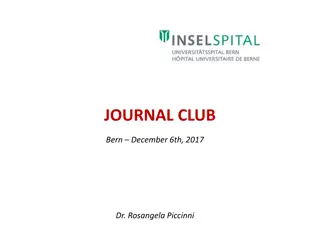Understanding Steatotic Liver Disease: Importance, Epidemiology, and Pathology
Steatotic liver disease, including metabolic dysfunction associated steatohepatitis (MASLD) and metabolic associated alcoholic liver disease (MALD), is a common cause of liver test abnormalities in the United States. Risk factors such as obesity and metabolic syndrome can lead to advanced fibrosis a
2 views • 44 slides
Strategies for Maintaining Liver Health in the New Year
The article discusses five effective strategies to improve liver health, focusing on caloric restriction, intermittent fasting, exercise, and caution in weight loss efforts. It emphasizes the importance of adopting healthy lifestyle interventions to prevent liver diseases such as NAFLD and provides
4 views • 14 slides
Liver Services at Imperial College Healthcare NHS Trust
The liver services at Imperial College Healthcare NHS Trust, led by Dr. Ameet Dhar, provide a comprehensive range of services for patients with liver conditions. With over 2000 new patients seen annually, services include inpatient care, specialist clinics, outreach programs, and referral pathways.
0 views • 14 slides
NGM282 in NASH: Phase 2 Study on Liver Fat Reduction and Histology Changes
A phase 2 study on NGM282 in NASH patients showed a significant decrease in liver fat content, meeting the primary endpoint. Exploratory findings also indicated potential improvements in liver histology. The treatment involved NGM282 at 3 mg QD, with additional rosuvastatin if needed. Promising resu
0 views • 11 slides
Medical Nutrition Therapy in Non-alcoholic Fatty Liver Disease
Medical Nutrition Therapy (MNT) plays a crucial role in managing Non-alcoholic Fatty Liver Disease (NAFLD), focusing on insulin resistance, metabolic syndrome, oxidative stress, dyslipidemia, and cardiovascular risk. Lifestyle recommendations include weight management and increasing physical activit
0 views • 36 slides
Revolutionizing Healthcare Software Design and User Control
Moonshot to revolutionize healthcare software design, making it safe, easy to use, and adaptable. The approach involves modular platform control for users, inspired by NASA's mission control software. The MedWISER model aims for clinician-driven, composable architecture in healthcare systems. Focus
0 views • 8 slides
Pharmacotherapy for Non-Alcoholic Fatty Liver Disease: An Updated Review by Anita Eftekharzadeh
This comprehensive review discusses the pharmacotherapy options for Non-Alcoholic Fatty Liver Disease (NAFLD), covering topics such as sub-classification of NAFLD, proposed risk stratification, non-invasive measures for assessing liver fibrosis, and the NAFLD Activity Score (NAS). Anita Eftekharzade
0 views • 44 slides
Benefits of Exercise Therapy in Nonalcoholic Fatty Liver Disease (NAFLD)
Exercise therapy plays a crucial role in managing nonalcoholic fatty liver disease (NAFLD) by improving hepatic aminotransferases and reducing steatosis. Lifestyle modifications, including increased physical activity, are essential in the treatment of NAFLD. This includes aerobic exercise, resistanc
0 views • 32 slides
Prediction of Liver Fibrosis in NAFLD Patients: Impact of CAP Values
Steatosis has emerged as a significant diagnosis with NAFLD becoming a common cause for hepatologic evaluation. Liver stiffness measurement (LSM) using transient elastography is vital for assessing fibrosis severity in NAFLD patients. However, the accuracy of LSM can be influenced by obesity and sev
0 views • 35 slides
Evaluation Methods for Liver Steatosis in Obese Children
This study examines the assessment of liver steatosis in obese children using MRI, ultrasound, and biology techniques, evaluating methods such as attenuation coefficient and proton density fat fraction. The aim is to develop noninvasive biomarkers and validate existing scores for predicting NAFLD. P
0 views • 22 slides
Managing Abnormal Liver Function Tests in Primary Care: Summary Guideline
Guideline drafted by Dr. Sally Hull and Dr. Lucy Carter focuses on identifying patients at risk of chronic liver disease, increasing testing for treatable liver conditions, and auditing prevalence of major liver diseases. The importance of diagnosing Non-Alcoholic Fatty Liver Disease (NAFLD) and str
0 views • 23 slides










